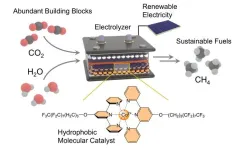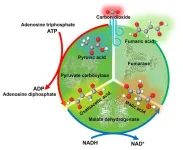(Press-News.org) (WASHINGTON – October 4, 2024) In the first study to report real-world outcomes from ciltacabtagene autoleucel (cilta-cel), a chimeric antigen receptor (CAR)-T therapy for multiple myeloma, patients experienced efficacy and safety results similar to those seen in clinical trials, according to results published today in Blood.
Of 236 patients who received cilta-cel infusions at 16 U.S. medical centers in 2022, 89% saw their cancer respond to the treatment and 70% had a complete response, meaning there was no detectable cancer after the treatment. These numbers are comparable to the results of the phase II CARTITUDE-1 trial that led to cilta-cel’s approval by the U.S. Food and Drug Administration (FDA), which showed a 98% response rate and an 83% complete response rate.
Most notable and encouraging, according to researchers, was that over half of the patients included in the new study would have been ineligible to participate in CARTITUDE-1.
“Even though in the real world a majority of patients are not as fit in terms of performance status, organ function, or baseline blood counts as they were in the clinical trial that led to FDA approval [of this therapy], these patients can do very well,” said Surbhi Sidana, MD, the study’s lead author and associate professor at Stanford University School of Medicine. “We saw very high response rates that appeared to be durable, despite over half of the patients not meeting [the trial’s] eligibility criteria. The response rates and time until progression of myeloma or death due to any reason was within the range of results observed in the clinical trial.”
Multiple myeloma is a cancer affecting plasma cells, a type of white blood cell. Currently about 40% of people diagnosed with multiple myeloma myeloma do not survive five years, and the prognosis is poorest in patients who do not see their cancer eradicated with standard treatments (refractory) or who see their cancer return after an initial response (relapsed). Two CAR-T therapies, where a patient’s own immune cells are removed, genetically altered, and then infused back into the body to attack and kill cancer cells, have been approved for use in these patients.
Cilta-cel was approved in 2022 for use in patients whose multiple myeloma had not been eradicated or had relapsed after four or more previous lines of therapy; the approval was expanded to earlier lines of treatment in April 2024. The new study focused on patients who had received treatment under the initial approval indication for heavily pre-treated patients. For the new study, researchers retrospectively analyzed outcomes among 255 patients who began the process of receiving cilta-cel in March through December of 2022. The study participants had undergone a median of six prior lines of therapy – and up to 18 lines of therapy – without seeing a lasting response.
Of the 255 patients who started the process of receiving cilta-cel, 236 (about 92%) underwent the full treatment. In addition to analyzing response rates of the whole study population, researchers examined outcomes among several subgroups. They found that patients who received the CAR T-cell product within the range specified by the FDA had a higher response rate (with 94% seeing a response overall and 76% seeing a complete response) compared with the one-fifth of patients whose CAR T cells did not fully conform to the quality standards specified by the FDA.
Researchers also examined a subgroup that included patients who had received prior therapies targeting B cell maturation antigen (BCMA), a protein found on multiple myeloma cells. Since cilta-cel targets BCMA, patients who had previously received such therapies were excluded from the CARTITUDE-1 trial. Researchers found that the 14% of study participants who fell into this category did show lower response rates than those who had not previously received BCMA targeted therapies, with the difference being most pronounced in patients who had received BCMA targeted therapies more recently. This suggests that further studies could help elucidate how the timing of cilta-cel and other BCMA targeted therapies may affect outcomes. The researchers also identified other key patient and disease characteristics that were associated with a lower likelihood of survival or a higher likelihood of disease progression.
Overall, rates of serious side effects were similar to those reported in previous clinical trials. The study found that three-quarters of those who received cilta-cel infusions experienced cytokine release syndrome (CRS), a common CAR-T side effect that can be severe, but only 5% experienced events of grade 3 or higher. Overall, 14% of study participants experienced neurotoxicity and 10% experienced delayed neurotoxicity; 2% experienced Parkinsonism.
“Delayed neurotoxicity is predominantly seen with cilta-cel [compared with other CAR-T therapies], and that’s another trade-off we should still be aware of,” said Dr. Sidana.
The study also found a relatively high rate of death (10%) unrelated to patients’ cancer, mostly from infections or CRS, suggesting that there may be room for improvement in decreasing infection risks and managing CRS.
As a retrospective, real-world study, the study did not include a control group and there may have been discrepancies in outcomes assessment and reporting among the 16 centers that contributed data. Researchers suggested that additional studies could help to identify opportunities to reduce serious side effects and determine whether using cilta-cel earlier during cancer treatment could help to lower the risk of toxicity.
###
Blood (www.bloodjournal.org), the most cited peer-reviewed publication in the field of hematology, is available weekly in print and online. Blood is the flagship journal of the Blood journals portfolio by the American Society of Hematology (ASH) (www.hematology.org).
Claire Whetzel, 202-629-5085
cwhetzel@hematology.org
END
A dedicated team of researchers from City University of Hong Kong (CityUHK) is pioneering cutting-edge generative artificial intelligence (GenAI) technologies on a collaborative innovation network platform, aimed at transforming science, technology and innovation (STI) services to empower research and innovation. This innovative project is set to revolutionise the related service delivery by creating a secure GenAI model and digitally transforming processes, thereby facilitating research development and technology innovation, while enhancing data security and service efficiency.
STI services, including ...
A recent position paper in the Asia-Pacific Journal of Ophthalmology explores the transformative potential of artificial intelligence (AI) in ophthalmology. Led by Lama Al-Aswad, Professor of Ophthalmology and Irene Heinz Given and John La Porte Given Research Professor of Ophthalmology II, of the Scheie Eye Institute, the work represents a collaboration among researchers from Penn Engineering, Penn Medicine, the University of Michigan Kellogg Eye Center, St. John Eye Hospital in Jerusalem, and Gyeongsang National University College of Medicine in Korea.
With fundus photography enabling the visualization ...
Vegetation cover across the Antarctic Peninsula has increased more than tenfold over the last four decades, new research shows.
The Antarctic Peninsula, like many polar regions, is warming faster than the global average, with extreme heat events in Antarctica becoming more common.
The new study – by the universities of Exeter and Hertfordshire, and the British Antarctic Survey – used satellite data to assess how much the Antarctic Peninsula has been “greening” in response to climate change.
It found that the area of vegetation ...
Every second, more than 3,000 stars are born in the visible universe. Many are surrounded by what astronomers call a protoplanetary disk – a swirling "pancake" of hot gas and dust from which planets form. The exact processes that give rise to stars and planetary systems, however, are still poorly understood.
A team of astronomers led by University of Arizona researchers has used NASA's James Webb Space Telescope to obtain some of the most detailed insights into the forces that shape protoplanetary disks. The observations offer glimpses into what our solar system may have looked like 4.6 billion years ago.
Specifically, the team was able to trace so-called ...
Black and Hispanic faculty members seeking promotion at research universities face career-damaging biases, with their scholarly production judged more harshly than that of their peers, according to a groundbreaking initiative co-led by the University of California, Merced that aims to uncover the roots of these biases and develop strategies for change.
Junior professors are generally evaluated and voted on for promotion and tenure by committees comprising senior colleagues. In one of the studies conducted by the research team, results suggest that faculty from underrepresented minorities received 7% more negative votes from ...
Climate change and economic inequality are deeply interconnected, with the potential to exacerbate each other if left unchecked. A new study published in Nature Climate Change sheds light on this critical relationship using data from eight large-scale Integrated Assessment Models (IAMs) to examine the distributional impacts of climate policies and climate risks. The study provides robust evidence that climate policies aligned with the Paris Agreement can mitigate long-term inequality while addressing climate change.
Led by Johannes Emmerling, Senior Scientist at the Euro-Mediterranean ...
Researchers at the University of Bonn and University of Montreal have developed a new type of catalyst and used it in their study to produce methane out of carbon dioxide and water in a highly efficient way using electricity. Methane can be used, for example, to heat apartments or as a starting material in the chemical industry. It is also the main component of natural gas. If it is produced using green electricity, however, it is largely climate neutral. The insights gained from the model system studied by the researchers can be transferred to large-scale technical ...
Houston, Texas – In a state-of-the-art Bench to Bedside review published in the journal Brain Medicine (Genomic Press), researchers Dr. Xiaoyu Song and Professor Jan-Åke Gustafsson from the University of Houston and Karolinska Institutet (Sweden) shed light on the therapeutic potential of liver X receptor beta (LXRβ) in treating depression and anxiety. This comprehensive analysis marks a significant step forward in understanding the molecular underpinnings of mental health disorders and potentially revolutionizing their treatment.
LXRβ, a nuclear receptor initially known for its role in cholesterol metabolism and inflammation, is now emerging as a crucial ...
As plastic waste continues to build up faster than it can decompose, the need for biodegradable solutions is evident.
Previously, Professor Yutaka Amao and his team at Osaka Metropolitan University’s Research Center for Artificial Photosynthesis succeeded in synthesizing fumaric acid, a raw material for biodegradable plastics from biomass-derived pyruvic acid and carbon dioxide. However, the fumaric acid production process reported earlier has a problem with producing undesirable substances as byproducts in addition to L-malic acid, which is ...
The oceans are warming at an alarming rate. 2023 shattered records across the world’s oceans, and was the first time that ocean temperatures exceeded 1oC over pre-industrial levels. This led to the emergence of a series of marine heatwave events across both hemispheres, from the waters around Japan, around South America, and across the wider North Atlantic. Marine heatwaves are periods of extremely warm sea temperatures that can form in quite localized hot spots but also span large parts of ocean ...




